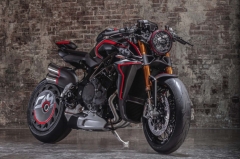Why do motorcycle helmets only last for 5 years?
Yes, your helmet does have an expiration date.

Helmets are essential accessories for motorcycle riders. They're the only things preventing our heads from hitting the pavement. Whether you’re out on the trail on a dirt bike or conquering the streets on a naked bike, chances are you’re wearing a good helmet.
That said, helmets don't last forever. While you may have a favorite that you wouldn't dare replace, your helmet has a prescribed expiration date that you would do well to follow. Most motorcycle helmets are safe to use for three to five years, but what's the reason behind this?
Parts of a motorcycle helmet
To understand why a motorcycle helmet expires, we first have to look at its composition and how the parts work together to keep you safe.
- Outer shell - This is the hard outermost layer of a helmet, often made of materials like thermoplastic, polycarbonate, carbon fiber, fiberglass, and other composites. The outer shell is not likely to degrade much over time unless it suffers an impact or sustains significant damage.
- EPS layer - Expanded polystyrene foam lines the inside of your helmet. This EPS material is lightweight and highly effective at absorbing impact. The layer works with the outer shell to minimize head trauma in case of a crash or accident. In helmets, the EPS layer also includes small ventilation ducts that conduct airflow and mitigate the heat. This layer may degrade with time, especially in the hot and humid climate we have in the Philippines.
- Interior padding - This is the soft, breathable material that helps with proper fit and riding comfort. With regular use, the padding may adjust to the shape of your head, providing an even better fit. In some helmets, the padding may be removable and easy to clean or replace.
- Visor or windshield - The visor is what protects your eyes and face from the elements when riding. It is usually made of clear polycarbonate and can offer some degree of ultraviolet ray (UV) protection. Dust, insects, road debris, and other particles are common sights for riders, so the windshield is necessary, especially at high speeds.
- Chinstrap - This is the adjustable mechanism that secures the helmet to your head. It is also the part most susceptible to wear and damage due to being exposed and handled often.
Having understood the parts of a helmet, we know that some components tend to break down more than others. The most significant is the EPS layer, which is normally tough, but may not last as long under the hot and humid climate we have locally. Constant exposure to heat, sweat, and UV rays can take a toll on the EPS material. Similarly, when other parts incur damage, it can also shorten a helmet's lifespan.
Why you should replace your helmet after around five years
Motorcycle helmets are generally durable and can last a long time. However, as a safety precaution, it is advisable to replace your helmet after a certain period has passed.
The manufacturing date is often used as an indicator for when to replace a helmet. A helmet's shelf life can be up to seven years. So, depending on the manufacturer, a helmet can last anywhere from three to five years after first use. For many helmet companies, five years is the prescribed lifespan. Beyond this period, the helmet's components may start to degrade, and riding safety may no longer be guaranteed.
How you use the helmet is also a factor. If you ride often or fail to maintain your helmet properly, it may not last for five years. Practice good helmet maintenance by keeping it out of the sun and washing the padding regularly. Also, make sure to buy genuine helmets from recognized manufacturers. If you take care of your helmet, you can maximize its lifespan, and it will serve you well for years to come.
Related Articles
-
5 things to remember when shopping for new motorcycle tires / Featured Article
Here are 5 things to consider when time comes for you to replace the tires on your motorcycle.
-
Can't ride your motorcycle because it's raining? Do these 4 things instead / Featured Article
Here’s a quick listicle of activities you can do if you can’t ride your motorcycle because of bad weather.
-
Which motorcycle jacket should you buy for your riding style? / Featured Article
There are a multitude of options when it comes to riding jackets. Let’s take a closer look at some of the most popular types.
-
Top 5 greatest motorcycle tech advancements of the modern era / Featured Article
Here are what we consider as the top 5 greatest motorcycle innovations of the past decade or so.
-
5 tips to keep thieves away from your motorcycle / Featured Article
Here are 5 things to consider when it comes to keeping your motorcycle safe and secure from prying eyes.
Latest Features
-
Last-minute Christmas gift ideas for your rider friends and family / Featured Article
Struggling to think of gift ideas for your motorcyclist friends and family? Read on to get some inspiration this gift-giving season.
-
Ride a naked sportbike? Get these 5 upgrades first / Featured Article
Here’s a quick list of 5 upgrades to your naked sportbike to enhance your riding experience.
-
Motorcycle 101: The inner workings of a slipper clutch / Featured Article
Slipper clutches are awesome as they make for more forgiving downshifts and a lighter clutch lever. Let’s take a closer look at them and see how they work.








